Have you ever caught a glimpse of a hummingbird flitting through the air with unmatched agility and grace? These tiny birds, known for their vibrant colors and incredible speed, captivate our attention as they zip around flowers and feeders.
But have you ever wondered why do hummingbirds swoop back and forth? Join us as we unravel the fascinating mystery behind why hummingbirds swoop back and forth in their airborne adventures.
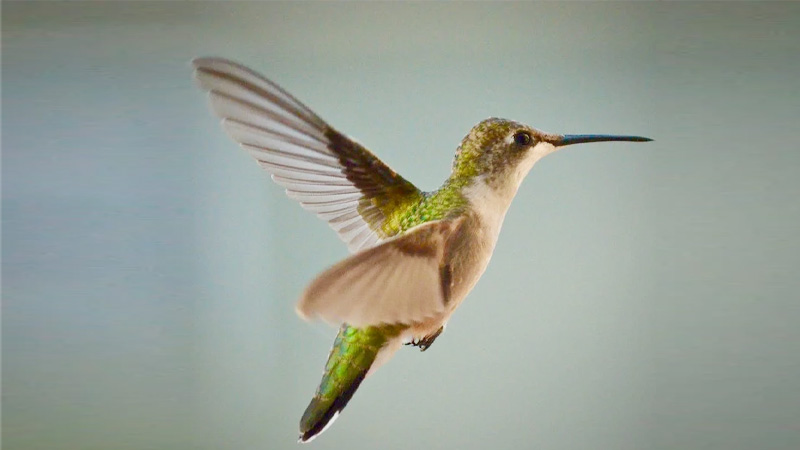
Why Do Hummingbirds Swoop Back and Forth?
Hummingbirds belong to the family Trochilidae, and they are the smallest birds in the avian world. They possess several remarkable adaptations that set them apart from other birds, such as their ability to hover in mid-air and fly backward.
But it is their distinctive swooping behavior that truly makes them aerial acrobats. So, why do hummingbirds swoop back and forth? Let’s find out:
Territorial Defense: Protecting Their Turf
One of the primary reasons is their need to defend their territories. These diminutive birds are fiercely territorial and will vigorously protect their feeding and nesting areas from intruders, including other hummingbirds.
Swooping back and forth is their way of warding off any potential threats and asserting their dominance. By swooping, they create an impressive visual display that warns other birds to keep their distance.
Courtship and Mating: Aerial Displays of Love
The swooping behavior also serves as a means of courtship and mating. Male hummingbirds showcase their agility and strength by performing elaborate aerial displays, including swooping, diving, and hovering.
These captivating acrobatics serve to impress and attract females. The more impressive the display, the higher the chances of winning a mate.
Feeding Strategy: Nectar Extraction Expertise
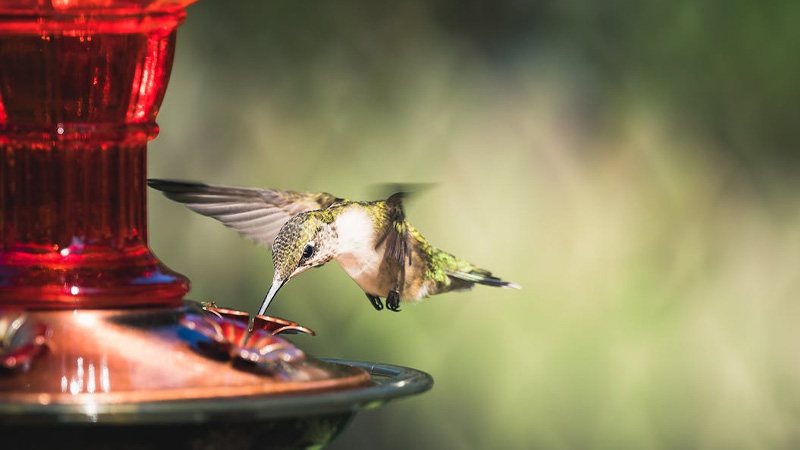
In addition to territorial defense and courtship, another reason for the hummingbirds’ swooping behavior is their feeding strategy. Hummingbirds have a high metabolic rate and need to consume a substantial amount of nectar to fuel their energetic lifestyles.
Their unique ability to hover and fly in any direction allows them to extract nectar from flowers with precision. Swooping back and forth allows them to access the nectar hidden deep within the flowers’ petals.
By sweeping their long, slender bills in a pendulum-like motion, they can thoroughly probe the floral tubes and savor every drop of sweet nectar.
Efficient Foraging: Snatching Insects with Precision
Furthermore, hummingbirds swoop to efficiently forage for tiny insects and spiders. These protein-rich morsels supplement their diet, providing the necessary nutrients for their survival.
The aerial swooping enables them to snatch insects out of the air or extract them from spider webs with astonishing precision. This unique foraging strategy allows hummingbirds to be versatile and adaptable in their search for sustenance.
Mastering Flight: The Art of Swooping
It’s worth mentioning that the swooping behavior can also be attributed to their exceptional flying skills. Hummingbirds are masters of flight, capable of reaching speeds of up to 60 miles per hour.
Their wings can beat at a rate of around 80 times per second, enabling them to hover in mid-air and change direction in an instant. Swooping back and forth allows them to navigate their environment effectively, avoid obstacles, and swiftly change their flight trajectory.
Why Do Hummingbirds Chase Each Other?
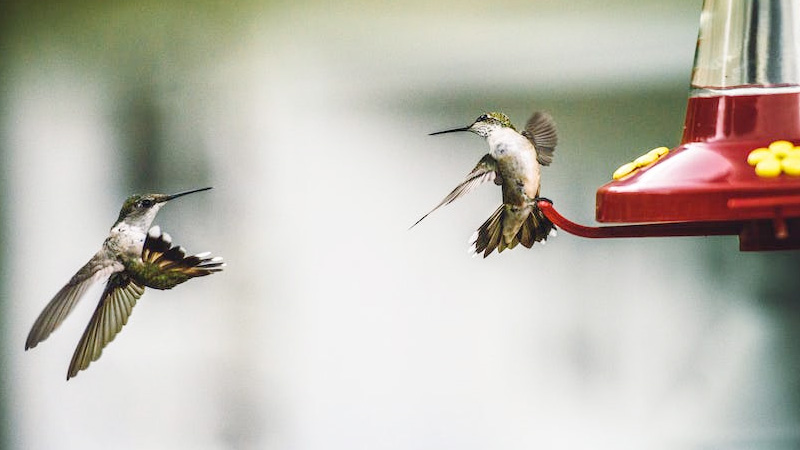
Hummingbirds are known for their territorial nature and can often be observed engaging in intense chases with other hummingbirds. These high-speed pursuits serve specific purposes and are driven by the following reasons:
Territory Defense Hummingbirds are fiercely protective of their feeding and nesting territories. When they perceive another hummingbird as a potential intruder, they engage in aggressive chasing behaviors to defend their space.
By chasing away rivals, they aim to establish and maintain exclusive access to valuable resources, such as nectar-rich flowers or prime nesting sites.
Mating Competition
During the breeding season, male hummingbirds may chase each other in pursuit of a female mate. The competition for reproductive success can be fierce, and these chases are a way for males to assert their dominance and vie for the attention of a female. The faster and more agile male often has an advantage in winning over a mate.
Courtship Displays
In some cases, the chasing behavior can be part of elaborate courtship displays. Males may engage in energetic chases as a way to attract and impress females. These displays can involve aerial acrobatics, with males showcasing their agility and flight skills to demonstrate their suitability as potential mates.
Resource Competition
Hummingbirds rely heavily on floral nectar as a fuel source. When nectar availability is limited or when there is a concentration of particularly desirable flowers, competition among hummingbirds can intensify.
Chasing each other can be a way to establish dominance and ensure access to these valuable nectar sources.
Boundary Enforcement
Hummingbirds may also chase each other to reinforce territorial boundaries. By actively patrolling and defending their territories, they communicate to other hummingbirds that they are not to encroach upon their space.
These boundary enforcement chases help maintain order and reduce conflicts within their overlapping ranges.
Why Do Hummingbirds Fly Straight Up and Then Dive Down?
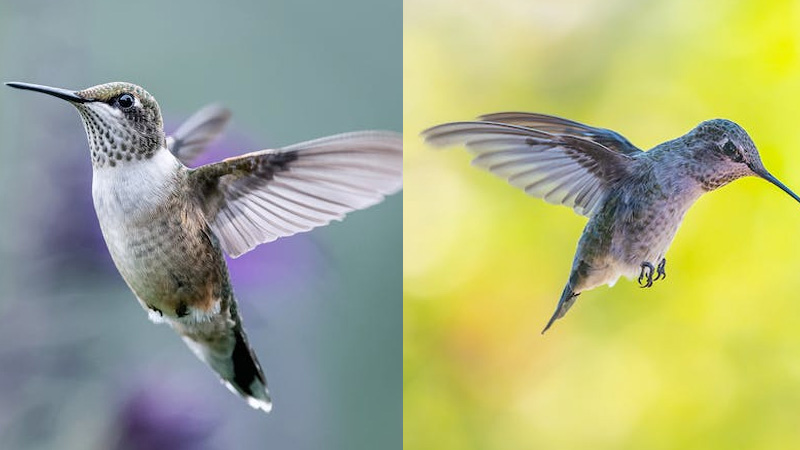
Hummingbirds are famous for their acrobatic flight capabilities, and one of their notable maneuvers is flying straight up and then diving down.
This behavior serves multiple purposes and is attributed to their unique physiology and foraging strategies. Let’s explore why hummingbirds perform this fascinating aerial feat:
Foraging Efficiency
Hummingbirds have a high metabolic rate and need to consume a significant amount of nectar to fuel their energetic lifestyles. Flying straight up allows them to gain altitude quickly, accessing elevated nectar sources like tall flowers or hanging feeders.
By diving down afterward, they can generate momentum and achieve greater speed, saving energy during the descent and reaching the next food source efficiently.
Maximizing Nectar Intake
Hummingbirds have long bills and tongues that are perfectly adapted for sipping nectar from flowers. When they fly straight up, they position themselves above the flower, enabling them to insert their bill deep into the nectar-rich blooms.
This upward approach allows them to access nectar that may otherwise be challenging to reach from a horizontal position.
Aerial Territory Display
Male hummingbirds often engage in aerial displays to defend their territories and attract mates. Flying straight up and then diving down can be part of their elaborate courtship rituals.
The ascent demonstrates their strength and agility, while the dive showcases their control and precision. These displays signal their fitness as potential mates and serve as visual spectacles to impress nearby females.
Aesthetic Appeal
The rapid ascent followed by a sudden dive creates an impressive visual display. Hummingbirds are known for their vibrant colors and iridescent feathers, and this aerial maneuver enhances their visual appeal.
It may attract attention from other hummingbirds, potential mates, or even human observers who are captivated by their stunning performances.
Agility and Flight Training
Hummingbirds are highly maneuverable and agile flyers. Flying straight up and then diving down helps them hone their flight skills, including rapid changes in direction and speed control.
These maneuvers contribute to their overall flight proficiency and ability to navigate complex environments effectively.
In summary, the behavior of hummingbirds flying straight up and diving down serves multiple purposes. It aids in foraging efficiency, maximizes nectar intake, displays territorial dominance, enhances visual appeal, and contributes to flight training.
How Hummingbirds Attract a Mate with Stunts?
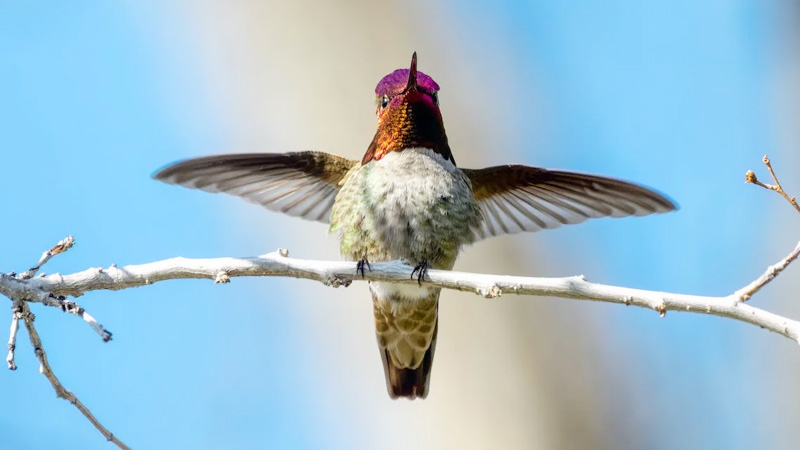
Hummingbirds are known for their incredible aerial displays, which play a crucial role in attracting a mate. These tiny birds showcase their agility, speed, and strength through various stunts that captivate the attention of potential partners.
Here’s how hummingbirds use their impressive moves to woo a mate:
Elaborate Flight Maneuvers
Male hummingbirds perform intricate flight patterns to impress females. These patterns often include swooping, diving, and hovering in mid-air. They exhibit precise control over their flight, showcasing their agility and mastery of aerial movements.
Wing Sounds and Tail Feathers
During their aerial displays, male hummingbirds produce distinct sounds with their rapidly beating wings. These sounds are often accompanied by impressive visual displays of their vibrant and iridescent tail feathers, which they spread out and flash to catch the light.
High-Speed Chases
Male hummingbirds engage in high-speed chases to demonstrate their speed and endurance. They dart through the air with lightning-fast movements, displaying their remarkable flight capabilities and stamina.
This pursuit not only showcases their physical prowess but also serves as a way to get the attention of a female.
Competitive Interactions
When multiple males are vying for the attention of a particular female, they may engage in competitive interactions. These interactions involve aerial battles, where males chase and dive at each other while vocalizing territorial or aggressive calls.
Courtship Dances
Once a male hummingbird has caught the interest of a female, he may engage in courtship dances. These dances involve elaborate movements, such as flying in a U-shape pattern or performing intricate aerial loops.
The combination of these stunts allows male hummingbirds to exhibit their physical prowess, attractiveness, and suitability as a mate. The more impressive and captivating the display, the higher the chances of successfully attracting a female.
FAQs
Hummingbirds are fiercely territorial and use swooping as a visual display to warn other birds to stay away from their feeding and nesting areas. By swooping back and forth, they assert their dominance and deter potential intruders.
Male hummingbirds perform impressive aerial displays, including swooping, diving, and hovering, to attract females. These acrobatic maneuvers showcase their agility and strength, increasing their chances of successfully courting a mate.
Swooping back and forth allows hummingbirds to access the nectar hidden deep within flowers’ petals. By sweeping their long bills in a pendulum-like motion, they can thoroughly probe the floral tubes, ensuring they extract as much nectar as possible.
Yes, hummingbirds incorporate swooping into their foraging strategy. Their swift and agile flight allows them to snatch insects out of the air or extract them from spider webs. This additional food source provides essential protein for their diet.
Hummingbirds are renowned for their mastery of flight. Their ability to hover, change direction instantly, and reach high speeds allows them to navigate their environment effectively.
Bottom Line
So, now you know why hummingbirds swoop back and forth. Hummingbirds swoop back and forth for various reasons, each showcasing their remarkable abilities and serving different purposes.
Whether it’s defending their territory, attracting a mate, accessing nectar, capturing insects, or exhibiting their unparalleled flying skills, these dazzling aerial acrobats never cease to amaze us.
So, the next time you catch sight of a hummingbird swooping through the air, take a moment to appreciate their natural talents and the wonders of the avian world.